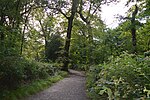Kenwood House
Art museums and galleries in LondonBuildings and structures in Hampstead HeathClan MurrayCountry houses in LondonEnglish Heritage sites in London ... and 13 more
Former private collections in the United KingdomGardens in LondonGeorgian architecture in the London Borough of CamdenGrade II* listed parks and gardens in LondonGrade I listed buildings in the London Borough of CamdenGrade I listed houses in LondonGrade I listed museum buildingsGuinness familyHistoric house museums in LondonHouses in HampsteadMuseums in the London Borough of CamdenNeoclassical architecture in LondonUse British English from May 2020

Kenwood House (also known as the Iveagh Bequest) is a former stately home in Hampstead, London, on the northern boundary of Hampstead Heath. The house was originally constructed in the 17th century and served as a residence for the Earls of Mansfield during the 18th and 19th centuries. The house and part of the grounds were bought from the 6th Earl of Mansfield in 1925 by Edward Guinness, 1st Earl of Iveagh, and donated to the nation in 1927. The entire estate came under ownership of the London County Council and was open to the public by the end of the 1920s. It remains a popular local tourist attraction.
Excerpt from the Wikipedia article Kenwood House (License: CC BY-SA 3.0, Authors, Images).Kenwood House
Lime Avenue, London
Geographical coordinates (GPS) Address Website External links Nearby Places Show on map
Geographical coordinates (GPS)
| Latitude | Longitude |
|---|---|
| N 51.5713 ° | E -0.1676 ° |
Address
Kenwood House
Lime Avenue
NW3 7JR London (London Borough of Camden)
England, United Kingdom
Open on Google Maps








